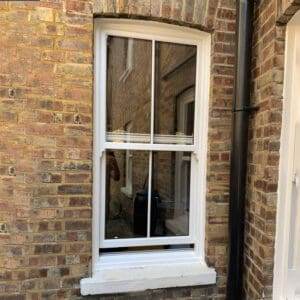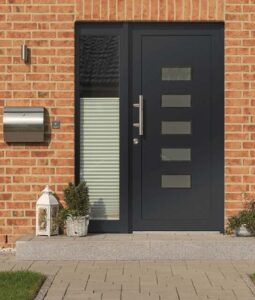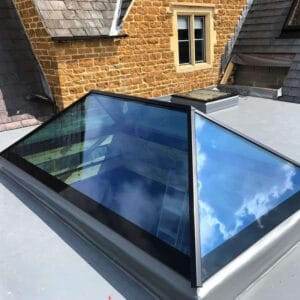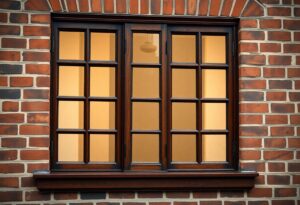Conflagration, a rare but devastating event, can pose a significant threat to the safety of buildings and occupants. When it comes to fire safety, wooden doors and windows require special consideration due to their potential to contribute significantly to the spread of fire. It is crucial to understand the fire resistance and performance of wooden doors and windows to ensure the overall safety of a building. In this blog post, we will discuss the important factors to consider when it comes to fire safety and wooden doors and windows, as well as the regulations and standards that must be met to enhance fire resistance. By the end of this post, you will have a better understanding of the importance of fire safety considerations for wooden doors and windows and how to ensure they meet the necessary fire safety requirements.
Key Takeaways:
- Proper maintenance of wooden doors and windows is crucial for fire safety. Regular inspections and repairs are essential to ensure their integrity in case of a fire.
- Choosing the right materials for wooden doors and windows is important. Fire-resistant wood and laminates can greatly improve their fire safety performance.
- Installation of fire-rated glazing on wooden windows can help contain the spread of fire and smoke. It is important to consider this when planning for fire safety in buildings.
- Applying fire-retardant coatings to wooden doors and windows can significantly improve their fire resistance. This extra layer of protection can make a difference in the event of a fire.
- Regular training and education for occupants on fire safety measures, including proper use of doors and windows for evacuation, is essential to ensure a safe response in case of a fire.

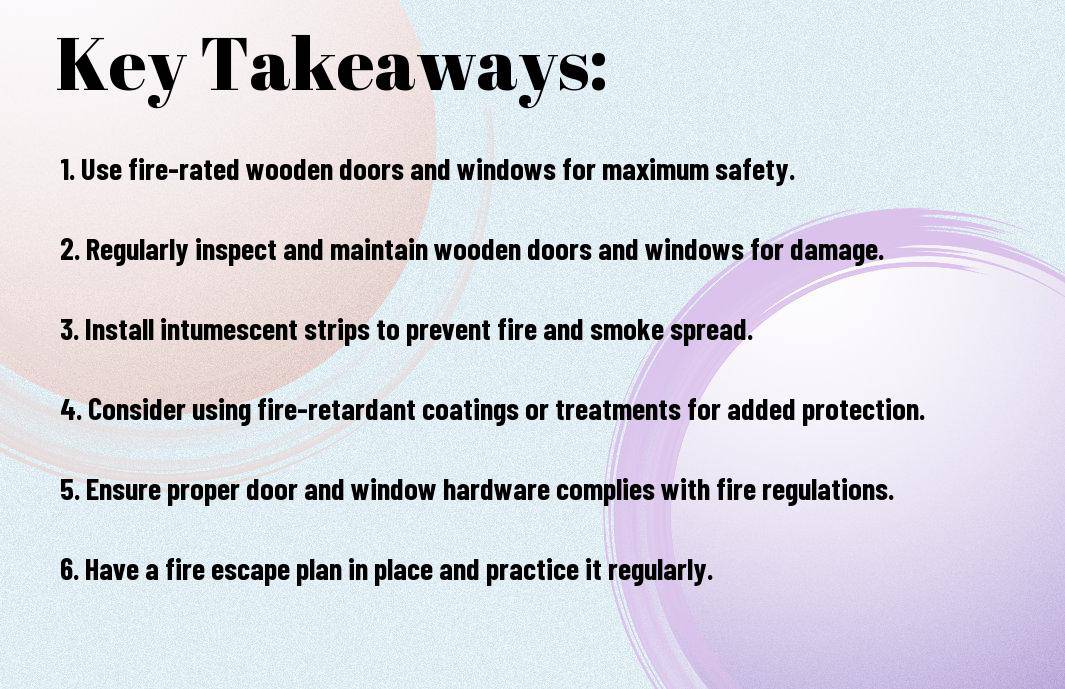
Characteristics of Wood in Fire
Wood is a commonly used material for doors and windows due to its aesthetic appeal and durability. However, when it comes to fire safety considerations, it is important to understand the characteristics of wood in fire. For important fire safety considerations for window and doorset installers, refer to Important Fire Safety Considerations for Window and …
Combustion Properties of Wood
Wood is a combustible material, meaning it has the ability to ignite and burn. When exposed to fire, wood undergoes a process of combustion, releasing heat, light, and various by-products such as smoke and gases. It is important to note that untreated wood can ignite at lower temperatures compared to treated or fire-retardant-treated wood.
During combustion, the heat released from burning wood can reach high temperatures, which can contribute to the rapid spread of fire. Moreover, the gases and smoke produced during the combustion of wood can pose significant hazards to occupants and firefighters.
Fire Resistance Ratings for Wooden Materials
Fire resistance ratings for wooden materials are determined based on their ability to withstand fire exposure. Wood can be engineered and treated to enhance its fire resistance properties, which in turn affects its fire rating. When selecting wooden doors and windows for a building, it is crucial to consider their fire resistance ratings, particularly in areas with stringent fire safety regulations.
It is important to note that wooden materials with higher fire resistance ratings provide better protection against the spread of fire, which can significantly improve the overall fire safety of a building.
Understanding the combustion properties and fire resistance ratings of wooden materials is essential for ensuring the fire safety of buildings, particularly in the context of door and window installations. By considering these factors, installers can make informed decisions to mitigate the risks associated with wooden doors and windows in the event of fire.
Fire Safety Requirements for Wooden Doors
When it comes to fire safety, wooden doors must meet certain requirements to ensure the protection of occupants and property in the event of a fire. This chapter will outline the necessary considerations for wooden doors to meet fire safety standards.
Building Code Specifications
Wooden doors used in buildings must adhere to specific building code requirements to ensure they are capable of withstanding fire for a certain period of time. These specifications often include the type of wood used, door thickness, and the installation of fire-resistant components such as intumescent seals and self-closing devices.
Treatments and Coatings for Fire Retardancy
Applying fire retardant treatments and coatings to wooden doors can significantly enhance their fire resistance. These treatments not only reduce the flammability of the wood but also prevent the spread of fire. They can be applied as varnishes, paints, or sprays to provide extra protection in the event of a fire.
It is important to note that fire retardant treatments should be regularly inspected and re-applied as needed to ensure their effectiveness over time.
Maintenance and Inspection Guidelines
Regular maintenance and inspection of wooden doors are crucial in ensuring their fire safety performance. This includes checking for any damage, ensuring proper functioning of fire safety components, and addressing any signs of wear or degradation. Inspections should be carried out by qualified professionals to prevent any potential fire hazards.
It is essential to follow the manufacturer’s guidelines for maintenance and inspections to maintain the integrity of the wooden doors in fire safety situations.
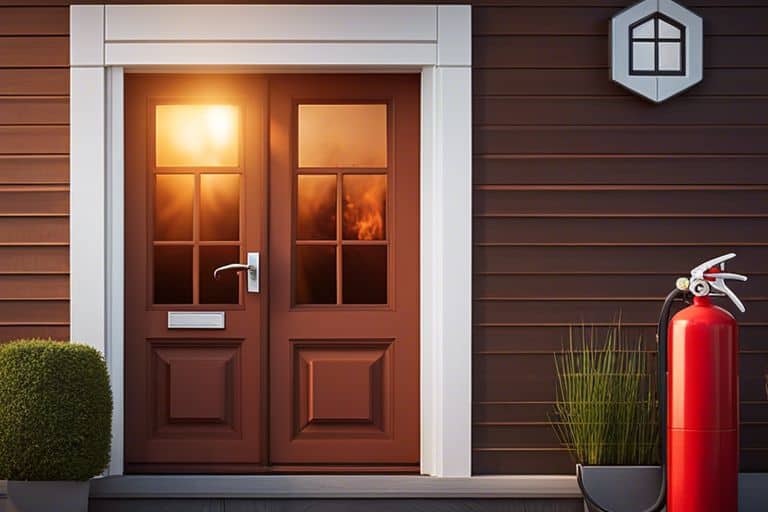
Fire Safety Solutions for Wooden Windows
When considering fire safety for wooden windows, there are several important factors to take into account. From glass and frame considerations to integration with fire escape plans, it’s crucial to ensure that wooden windows are equipped to minimise the risk of fire.
Glass and Frame Considerations
When it comes to wooden windows, the type of glass and the frame material play a significant role in fire safety. Specialised fire-resistant glass can be installed to prevent the spread of fire in the event of an emergency. Additionally, choosing fire-retardant wooden frames can further enhance the safety of the windows.
Integration with Fire Escape Plans
Wooden windows should be seamlessly integrated with fire escape plans to ensure a swift and safe evacuation in the event of a fire. It is essential to consider the size and placement of windows for effective escape routes, as well as ensuring that windows can be easily opened from the inside in case of an emergency.
Furthermore, regular drills and practice of fire escape plans should involve using wooden windows as a primary means of evacuation, ensuring that all inhabitants are familiar with the process and able to execute it effectively in the event of a fire.
Case Studies and Best Practices
In this chapter, we will explore case studies and best practices related to fire safety considerations for wooden doors and windows. We will delve into real-life examples and data-driven analysis to understand the impact and efficacy of various fire-safe installations.
- Case Study 1: A comparison of fire incident data before and after the installation of fire-resistant wooden doors and windows. (Source: Fire Doors and Windows, etc.)
- Case Study 2: Analysis of the effectiveness of different fire-retardant coatings on wooden doors and windows.
- Case Study 3: Best practices in fire safety measures for wooden doors and windows in high-risk areas.
Successful Implementations of Fire-Safe Wooden Installations
Several successful implementations of fire-safe wooden installations have demonstrated the importance of compliance with fire safety standards. These case studies highlight the positive impact of properly installed and maintained fire-resistant wooden doors and windows in preventing the spread of fires.
Lessons Learned from Fire Incidents
Despite the advancements in fire safety technology, there have been lessons learned from fire incidents involving wooden doors and windows. It is crucial to examine these cases to understand the weaknesses and challenges associated with fire-resistant wooden installations. This analysis will inform improvements in design, material selection, and maintenance practices to reduce the likelihood of fire incidents.
For more information on Lessons Learned from Fire Incidents, please refer to the comprehensive report on Fire Doors and Windows, etc.
Fire Safety Considerations for Wooden Doors and Windows
When considering fire safety in buildings with wooden doors and windows, it is imperative to take certain precautions and considerations into account. While wooden doors and windows can provide an aesthetically pleasing and traditional look to a building, they can also pose a potential fire hazard if not properly maintained and protected. It is crucial to ensure that all wooden doors and windows are treated with fire retardant coatings and are regularly inspected for any signs of wear or damage. Additionally, it is important to have adequate fire safety measures in place, such as fire alarms, smoke detectors, and fire extinguishers, to quickly respond to any potential fire threats. By taking these precautions, we can ensure that the beauty and charm of wooden doors and windows can coexist with the necessary fire safety measures, providing both a visually appealing and safe environment for building occupants.
Fire Safety Considerations for Wooden Doors and Windows
Q: Are wooden doors and windows safe in the event of a fire?
A: Wooden doors and windows can be safe in a fire, but it is important to ensure that they meet fire safety regulations and are properly maintained.
Q: What are some fire safety features to look for in wooden doors and windows?
A: Look for fire-rated doors and windows that have been tested and approved for their ability to withstand fire and prevent its spread.
Q: How can I ensure that my wooden doors and windows meet fire safety standards?
A: Have your doors and windows regularly inspected and maintained by a professional to ensure they meet fire safety regulations and will perform as intended in the event of a fire.
Q: What additional measures can be taken to enhance the fire safety of wooden doors and windows?
A: Consider installing fire-resistant glass in windows and using intumescent fire seals around the edges of doors to help prevent the spread of fire and smoke.
Q: What should I do in the event of a fire if I have wooden doors and windows?
A: In the event of a fire, immediately evacuate the building and close all doors behind you to help contain the fire. If safe to do so, use designated fire exits and follow the established fire evacuation procedures.



